
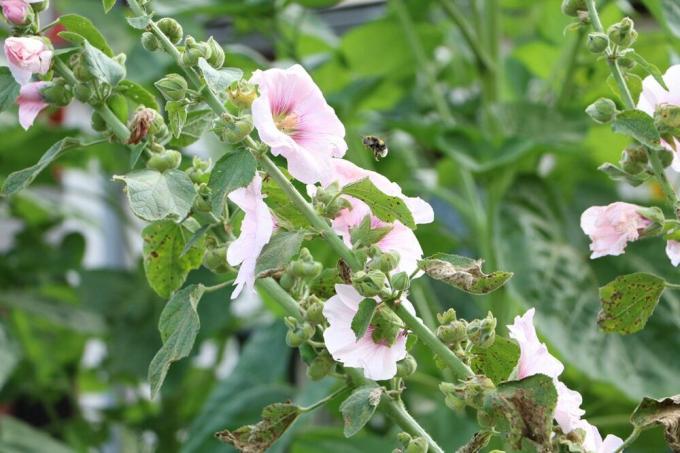
Table of contents
- Location
- Floor
- Plant
- tub planting
- Care
- Pour
- Fertilize
- Cut
- hibernate
- multiply
- Special species and varieties
- Diseases
- pests
- Tips for optimal growth of the hollyhock
Like a candle, the peasant rose rises up to two meters into the sky. The cup-shaped flowers, which usually have a dark throat, bloom from June to September, depending on the location. They are particularly beautiful to look at in a cottage garden, but they also set beautiful accents in all other home gardens. And the mallow plants hardly need any care.
Location
Around the beautiful hollyhock, also hollyhock (Alcea rosea) To offer optimal conditions for healthy and strong growth, a location with as much sunlight as possible is necessary. However, it also adapts well to bright, partially shaded spots in the garden. Look for a sheltered spot, because hollyhocks grow to a height of around two meters and are therefore sensitive to wind. Specimens and varieties that grow particularly tall are therefore best fixed to a plant stick.
- as sunny as possible
- also light penumbra
- tolerates heat
- sheltered from the wind
- south side of the bed
- southern or western house wall
Floor
Even if farm roses do well in somewhat drier conditions, they do best in a spot in the garden where the soil can retain moisture well. Otherwise, their claims are rather low. The rustic rose grows easily in all normal garden soils. However, these should be loose and deep, as the hollyhock develops long taproots. If the soil is sandy, adding compost or mulch will help keep the soil from becoming too hard and compacted.
- nutritious
- good water permeability
- fresh to slightly moist
- relaxed
- pH value: neutral (6.5 to 7.2)
Plant
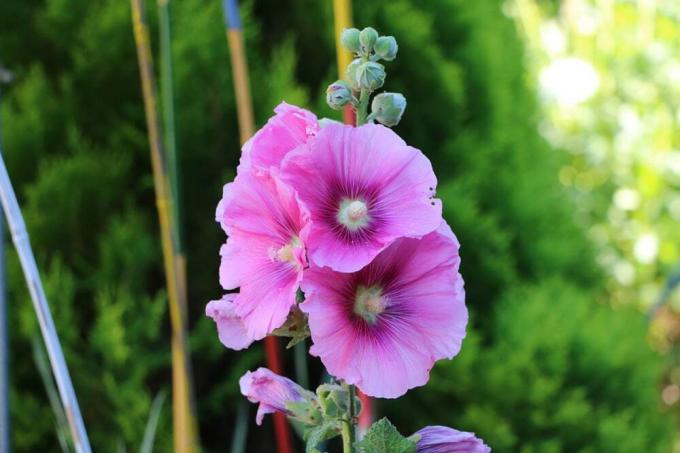
Early garden papelroses can be planted outdoors from the ice saints in mid-May to the beginning of June. If the garden soil is not optimal, it should be improved before planting.
- Time: mid-May
- generally possible all year round (in frost-free weather)
- sandy soil: mix in compost or potting soil
- compacted soils: add compost and sand
- dig deep and loosen up
- Remove stones and weeds
- Planting depth: as before
- Planting distance: at least 50 cm
tub planting
The hollyhock is also suitable for cultivation in a planter. Make sure that the planter is high enough, because the garden papelrose forms a long taproot. Due to its enormous growth, only one plant should be used in each container.
Care
Farmhouse roses are one of the beauties of flowering plants that require very little care. Most hollyhocks are herbaceous plants with a lifespan of two years, which only sprout ground-level foliage in the first year. Only in the second year do upright stems, one to three meters high, with a terminal, racemose inflorescence grow. Single hollyhocks are usually short-lived perennials that grow perennial.
Pour
It is essential to ensure an even water supply so that the garden papelrose can develop well. Especially on sandy soils, it must therefore be watered daily in hot, dry times. Otherwise, it is quite sufficient to water the mallow plant deeply once a week during flowering. However, avoid waterlogging, as this has an unfavorable effect on the development of the flowers. Be sure to only water the plant from below, that is, not over the leaves. Otherwise, the hollyhock becomes susceptible to diseases.
Fertilize
Nutrients are necessary for the hollyhock to grow vigorously and form lush flowers. It is therefore best to work some compost or other organic fertilizer into the soil around the plants with a spade fork or similar tool in spring before they sprout in April. In addition, some bone meal is necessary in August to stimulate root growth.
- Timing: spring and late summer
- Compost, seaweed meal, horn shavings, bone meal
- Fertilize potted plants regularly with the irrigation water or with long-term fertilizer
Cut
The timing of the pruning depends on whether you want the farm rose to reproduce naturally in the garden or not. If you want to prevent self-seeding, simply cut the shoot with the withered flowers or still closed seed pods down to a height of 10 cm. In this case, the unfilled varieties usually bloom again in the following year.
- Cut back after flowering: no propagation
- Cutting in the fall: self-sowing
- do not cut lower leaf rosette before withering
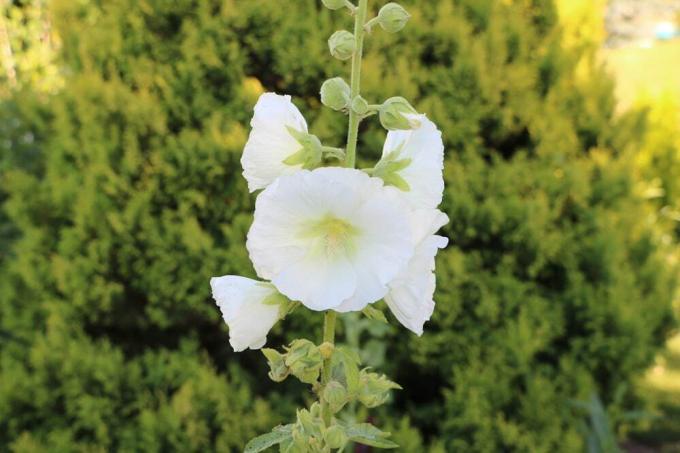
The autumn cut takes place at the earliest when all parts of the plant are already dead and dry. Since the hollyhock is at least biennial, it still has to store sufficient amounts of nutrients in the underground parts of the plant until October. To do this, she needs her leaves.
hibernate
Hollyhocks are sufficiently hardy under normal winter conditions in Central Europe, so that no additional winter protection is necessary. Even young plants survive the cold winter months without any problems. The only things that need special attention are potted plants:
- use frost-proof containers
- at temperatures above 0 degrees: water regularly
- Balls must not dry out
multiply
Hollyhocks are easy to grow from seed. These can either be self-harvested seeds, if there are already flowering specimens in the garden, or seeds bought from the trade. If you want to grow hollyhocks yourself from seeds, you should consider that they only bloom in the second year. Various methods have proven themselves for successful cultivation:
1. Breeding on the windowsill
If you want to plant the common rose in the bed in spring, you can grow it indoors on the windowsill from the end of February to mid-March. For this you need:
- Mini greenhouse with lid
- alternatively small growing pots
- Foil or freezer bag to cover
- Bowl or plate to put on
- Substrate: poor in nutrients and well drained
- Sowing soil or cactus soil
Place one or two seeds in a pot filled with substrate and cover them with a layer of fine sand. Then you put a freezer bag with the opening down over the pot and fix it with a rubber band. So that the seeds are not washed away when watering, fill the saucer with a little water. Once this has been absorbed, it is again filled with water about one centimeter high. After about two to three weeks in a warm, bright place without direct sunlight, the first seedlings will be visible. The cover can now be removed. Keep the small plants slightly moist. From mid-May they can then be planted in their final location in the bed.
2. Direct sowing in the bed
From April to May, the seeds of the common mallow can also be sown directly outdoors. So that the waiting time for flowering in the next season is not too long, it is also possible to sow the seeds in the bed in late summer. At this point, the seed will also germinate and form its first leaves before winter. To do this, loosen the soil deeply and, if necessary, add some mature compost, sand or horn shavings.
- When: April/May or end of July/August
- Scatter the seeds loosely over the bed
- Work in lightly with a rake
- alternatively cover about 2 cm with loose substrate
- water carefully (with a fine spray jet of the garden hose)
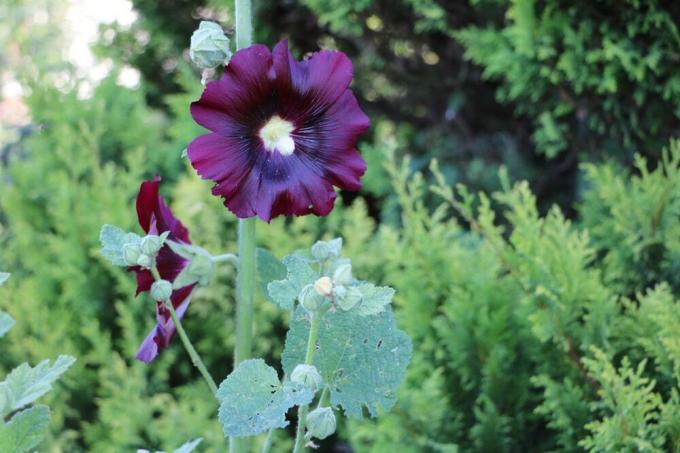
After germination, let the young seedlings grow until the first pair of leaves appear after the cotyledons. Separate the small hollyhocks at the appropriate planting distance or place them in their final location in the garden.
Special species and varieties
Hollyhocks belong to the mallow family and, with around 60 species, are mainly native to southern and eastern Europe and central Asia. The selection of hollyhocks is enormous. If you like it particularly colourful, it is best to choose a magnificent mixture of different colors right away. There are also variants with filled or simple, unfilled flowers.
Alcea rosea hybrid 'Parkallee'
- perennial variety
- Flowers light yellow, semi-double
- Growth height: 150 to 180 cm
- Planting distance 80 cm
Alcea rosea 'Nigra' (Black Hollyhock)
- usually biennial
- single, black-red flower
- Growth height: up to 2 m
- Planting distance: 70 cm
Alcea rosea plena 'Chaters Chamois'
- Double variety with apricot colored flowers
- Lifespan: two years
- Growth height: up to 2 m
- Planting distance: 50 cm
Alcea rosea plena 'Chaters White'
- double white flowers
- Lifespan: two years
- Growth height: up to 2 m
- Planting distance: 50 cm
Alcea Rosea hybrid 'Mars Magic'
- perennial variety
- velvety red flowers with a special luminosity
- Growth height: up to 2 m
- Planting distance: 70 cm
Diseases
Like all mallow plants, the peasant roses are also susceptible to the mallow or hollyhock rust, especially in humid weather. Infected plants can be identified by the yellowish to orange pustules on the underside of the leaves. Always remove infested leaves promptly and do not dispose of them in the compost but in household waste. In autumn, the plant should be cut back to the ground. Biologically harmless home remedies such as horsetail decoction are suitable sprays:
- fresh or dried field horsetail
- alternatively: yarrow
- soak in water for a day
- Simmer gently for 30 minutes
- strain
- Spray on infected plants with a spray bottle
pests
In spring, the snails in the garden like to attack the young leaves of the hollyhock. Good protection against snails is therefore essential.
weevil
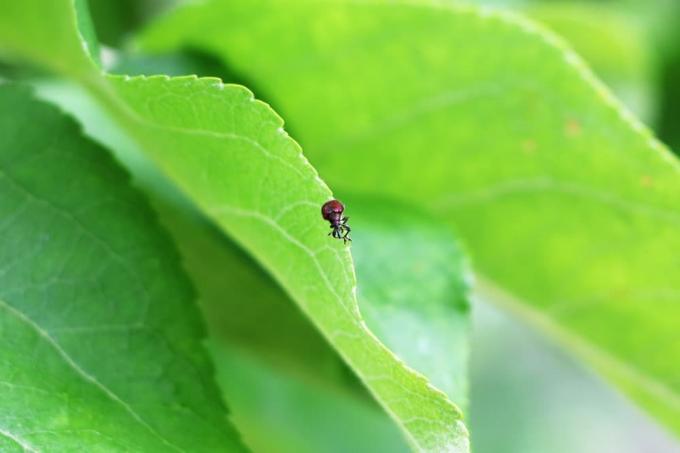
In spring and early summer, weevils often eat holes in the leaves and flower buds of the slender, tall-growing haricot roses to lay their eggs in. In order to prevent the weevil from infesting the rosette next year, the seed pods of affected plants should be removed in autumn and burned or disposed of with household waste. Because the weevil larvae hatch and mature in the seeds and overwinter in the ground.
Tips for optimal growth of the hollyhock
- Since double flowering and very tall specimens of hollyhocks quickly become top-heavy when the flowers fill with water when it rains, it is best to tie them to a plant stake.
- Medium-sized ornamental grasses planted in front of the hollyhocks are suitable for hiding old, dead leaves.
- Cutting off the blooms of haricot roses as soon as they wilt will extend their lifespan beyond the normal two to three year period.
- Don't plant your rosettes too densely so that the foliage can dry off well in damp weather. Excessive moisture on the leaves encourages hollyhock rust infestation.
- The more nitrogen there is in the soil, the bigger the flowers will grow. Therefore, fertilize your hollyhocks regularly.
 garden editorial
garden editorial I write about everything that interests me in my garden.
Learn more about perennials

20 hardy plants that bloom all year round
With plants that flower all year round, you can quickly create an attractive garden that does not require much maintenance, as long as the plants are also hardy. In this post, we will introduce you to 20 plants that are suitable for this.

17 flowering hardy plants May to October
Many plants only show their full splendor for a short time. But there are also types and varieties with a particularly long flowering period from May to October, sometimes even longer. We present 17 flowering hardy plants.

Hardy perennials: 22 perennial bloomers
Hardy perennials as permanent bloomers in the flower bed enchant the garden from early summer to autumn with a colorful bloom. They are easy to care for and magically attract butterflies, bees and the like.

10 care tips for the banana tree
If you like it exotic, cultivate a banana tree as a houseplant or in the conservatory. In summer, the banana plants are even allowed outside for a few weeks. The large leaves that the Musa forms on a false trunk are particularly decorative and impressive, and therefore look like a small tree.

Properly care for globe thistle | 10 tips for care
The globe thistle is an eye-catcher in the garden. Their spherical flowers provide a food source for insects. The globe thistle is not difficult to care for and it is suitable for dry locations. With a few tips on care, the plants will develop even better.
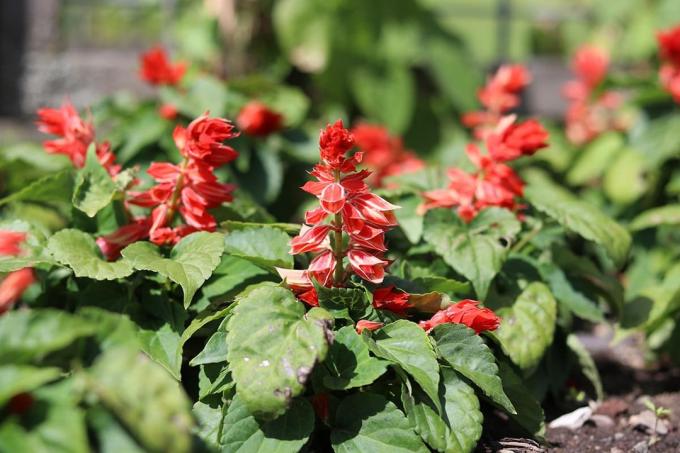
Fire sage, Salvia splendens: care from A to Z
Fire sage is known in botanical jargon as Salvia splendens and is a particularly decorative eye-catcher. But what kind of care does the plant need? Our guide to the salvia shows the important points from A to Z.
